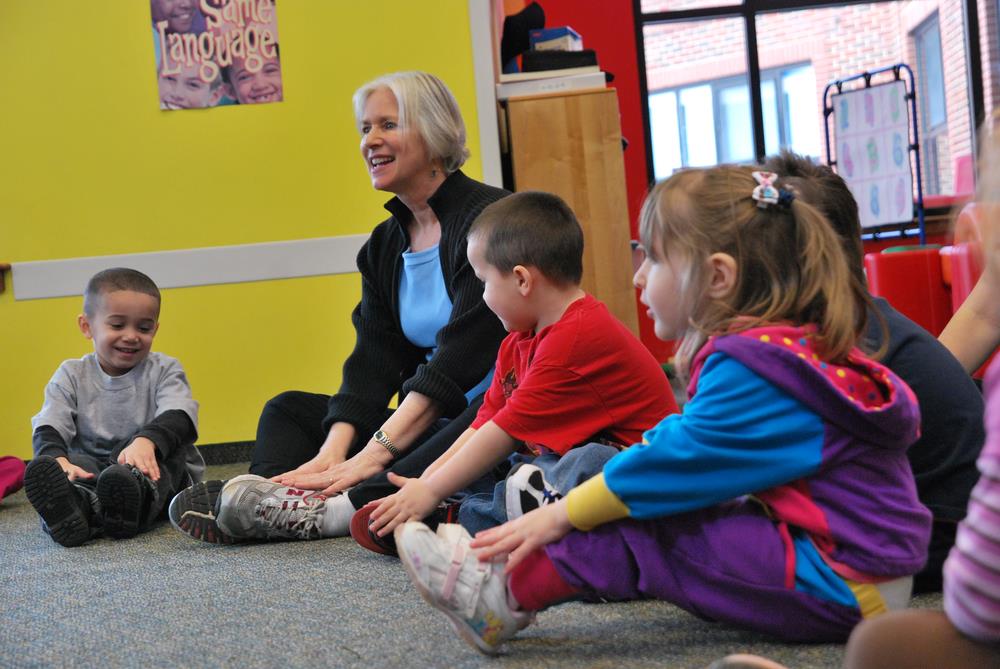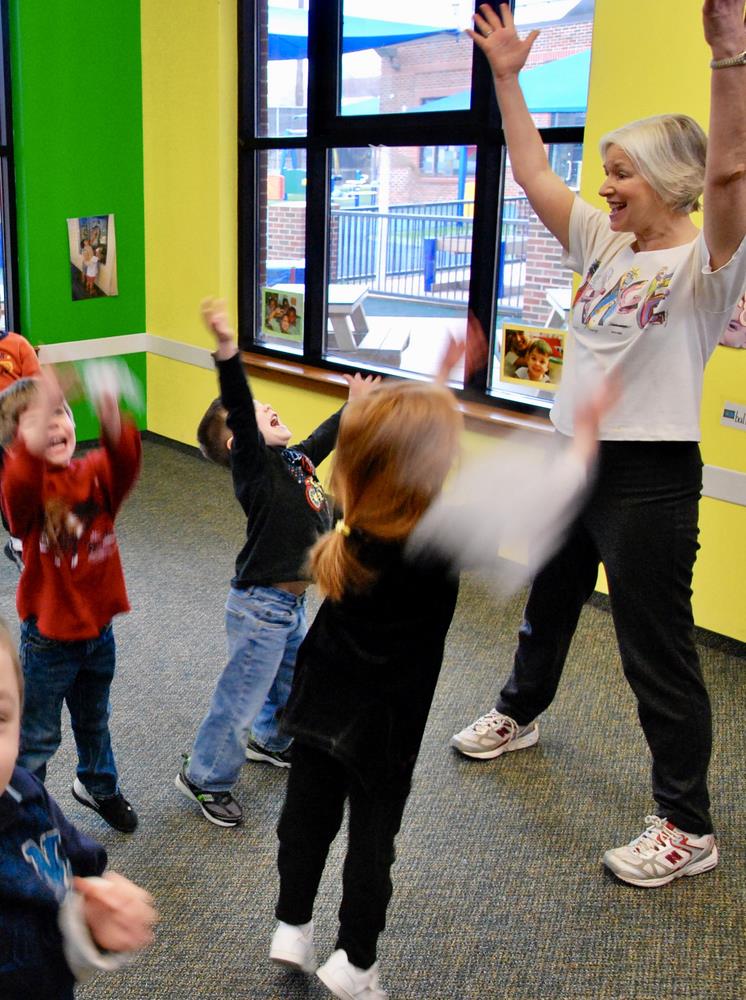NDEO’s Guest Blog Series features posts written by our members about their experiences in the fields of dance and dance education. We continue this series with a contribution by Connie Dow, Dance Educator and Author. Guest posts reflect the experiences, opinions, and viewpoints of the author and are printed here with their permission. NDEO does not endorse any business, product, or service mentioned in guest blog posts. If you are interested in learning more about the guest blogger program or submitting an article for consideration, please visit this link.
“Movement, Play, and SEL: Create a Picture Book Dance Story” originally appeared at freespiritpublishingblog.com. Copyright © 2021 by Free Spirit Publishing. Used with permission. All rights reserved.
Movement, Play, and SEL: Create a Picture Book Dance Story
By Connie Bergstein Dow, Dance Educator and Author
Over my long career as a dance educator, I have especially enjoyed teaching creative dance to young children. I love inspiring their enormous and fertile imaginations to explore ideas through movement. Picture books have been the catalyst for many of our lively, creative dance sessions. Each book we read is a rich source of movement ideas. Children enjoy revisiting the book, and through a teacher’s open-ended movement prompts and the children’s own kinesthetic responses, the resulting explorations can be energetic, playful, and enriching.

Photo by Kevin Wauligman
Children love to bring stories alive using dance and music. In addition to the dramatic play and the joy of being physically active and moving to music, this activity offers many other benefits, including learning concepts from the early childhood curriculum, as well as SEL skills:
-
Comprehension
-
Making predictions
-
Sequencing
-
Identifying with and understanding different characters in a story
-
Exploring and learning about the story’s setting and background
-
Vocabulary acquisition
-
Recognition of rhyme and rhythm
-
Alphabet knowledge and letter recognition
-
Listening skills
-
Body control and awareness
-
Creativity
-
Problem solving: Both individually and as part of a group
-
Curriculum enrichment: Adds the “A” for Art (Dance) and the “R” for Reading to expand STEM subjects from STEM to STEAM to STREAM
-
Manipulating Props: I often add props to the stories (for example: white shower scrubbies for snowballs if it is a story about winter, sparkly streamers if it is a story about the night sky). Children learn to control and manipulate objects while they are moving, in addition to learning to be aware and considerate of other children in the space who are also using props.
Bonus Benefits
-
Expand the format: Dance stories can also be created from songs and poems.
-
Great for informal group productions: Use your dance story as the basis for a performance for families and friends. Add optional costumes, props, and scenery!

Photo by Kevin Wauligman
Two Dance Stories to Use with Your Group
Below are two dance stories. The first is from a concept picture book, and the second is from a picture book with a story arc. Both have a number of action words to inspire playful movement ideas, and both wrap up the activity by bringing the children to a quiet finish. A dance story can be a very short activity (10 minutes or so), or can be expanded into a much longer one. The two dance stories below would take about 20-30 minutes including reading the book, going through the various prompts, winding down the story, and bringing the children to a calm and quiet ending.
Dance the Alphabet! A Dance Story Based on My Book From A to Z with Energy!
The underlying theme of my rhyming alphabet book, From A to Z with Energy!, is the joy of being active. Begin by reading the story aloud to the group of children. Then ask them to spread out in the available space. This dance story can be done with each child in their own spots (invite them to move around on their spots if they are to stay in one particular area), or with everyone moving throughout the space. Play some upbeat instrumental music, if available, and call out the prompts below, one by one. Allow plenty of time between prompts so children can fully explore their ideas.
-
A: What activities do you like to do? Dance about something you would like to do outside today!
-
B: How many ways can you move the different parts of your body? First move your head, then your arms, shoulders, fingers, torso, legs, feet, toes. Now try to move all of the parts at the same time!
-
C: Can you clap your hands over your head? Behind your back? While you are bending forward? How else can you clap your hands?
-
D: Can you clap and dance at the same time?
-
E: How do you move when you are very tired? How about when you feel energetic?
-
F: What do you like to do that is the most fun for you? Dance about it!
-
G: Run in place as fast as you can! Ready, set, GO!
-
H: Play a pretend game of hopscotch.
-
I: Put on your imaginary ice skates. Skate around the ice!
-
J: Jump as high as you can.
-
K: Imagine you are swimming outside on a warm summer day. Float, kick, splash!
-
L: What do you like to eat for lunch? Sit down and take a break to eat your pretend lunch.
-
M: Your muscles are stretchy, like rubber bands. Stretch your arms, legs, and torso.
-
N and O: Let’s imagine we take a nature walk outside. Hike, climb, and wade through a creek. What do you see? What do you hear?
-
P: Pretend you are at a playground. Swing, slide, and walk across a balance beam.
-
Q: Put on your snowsuit, and slide quickly down a big hill on a sled!
-
R: Line up at a starting line, and imagine you are racing.
-
S: Using a pretend soccer ball, try dribbling down the field, passing to a teammate, and scoring a goal.
-
T: Twirl one way, then the other! Slowly fall and imagine landing in the soft grass.
-
U: Stand at home plate with a pretend bat in your hand. Imagine a pitcher throws a ball. Swing the bat, and hit a home run! Watch the ball as it goes up, up, up, and then over the fence.
-
V: All of this dancing is very tiring! Let’s start walking home at the end of a long day.
-
W: Continue walking, and imagine you are walking home. Look up at the moon!
-
X, Y, Z: Take a big exhale! Yawn and stretch. Lie down, and close your eyes. Sweet dreams! Zzzz.
Let’s Create an Impossible Garden! A Dance Story Based on Jayden’s Impossible Garden by Mélina Mangal
As in the dance story above, start by reading the book aloud. Play some quiet instrumental background music, if available. Then proceed with the following movement prompts, allowing time for children to respond to each:
1. Jayden loved nature. He liked to imagine he was in a tree house. Pretend to climb a tree, like Jayden did in his imagination.
2. He wanted to show his mother that nature was everywhere, even in the city. Jayden saw squirrels scurrying around. Be a squirrel! He saw cardinals. Can you fly like a cardinal?
3. Imagine you are Mr. Curtis. Pretend to move your wheelchair toward the apartment building by holding onto the big wheels and pushing them slowly. Feel the cool breeze and the sunshine on your face.
4. Can you build a secret fort? Collect wood, boxes, stones, and sticks. When you are finished, stand back and admire it. Now climb inside!
5. Plant a magical garden. Collect pots and decorate them. Put soil in each one. Add seeds. Water them carefully.
6. Can you be a busy ant, like the ones Jayden and Mr. Curtis saw? Now pretend you are the caterpillar that was the guardian of the garden. Crawl around, find a leaf, and munch on it! Can you imagine you are a spider, weaving a web?
7. Make a tiny hammock for your fort, just like Jayden did.
8. Gather together Mama and other people from your neighborhood. Show them all of the different things in your impossible garden. There is nature in the city!
9. Fly like a butterfly. Now fly like a hummingbird, beating your tiny wings very fast.
10. Finish by imagining you are flying like a dove, then landing gently in your nest on the hammock on top of your fort.
The general format of these two dance stories can be used over and over. Children will look forward to hearing you say, “Now let’s dance the story!”
For more movement resources, ideas for a variety of activities, and dance stories I have created from picture books and original stories and poems, visit my blog. All have detailed instructions, prop suggestions, ideas for expanding the activities, and much, much more!
 Connie Bergstein Dow took her first dance class when she was four years old and has been dancing ever since. After attending Denison University and earning an MFA from the University of Michigan, she danced professionally in the United States, Venezuela, and Guatemala. Connie has had a long career as a dance educator and has written two books for teachers about integrating movement into the early childhood classroom, articles for magazines and journals, and verses for Highlights. She shares her passion for dance by writing, teaching, volunteering, visiting schools and libraries, and offering movement workshops to early childhood professionals. Visit Connie at www.movingislearning.com. Headshot by Helen Adams.
Connie Bergstein Dow took her first dance class when she was four years old and has been dancing ever since. After attending Denison University and earning an MFA from the University of Michigan, she danced professionally in the United States, Venezuela, and Guatemala. Connie has had a long career as a dance educator and has written two books for teachers about integrating movement into the early childhood classroom, articles for magazines and journals, and verses for Highlights. She shares her passion for dance by writing, teaching, volunteering, visiting schools and libraries, and offering movement workshops to early childhood professionals. Visit Connie at www.movingislearning.com. Headshot by Helen Adams.